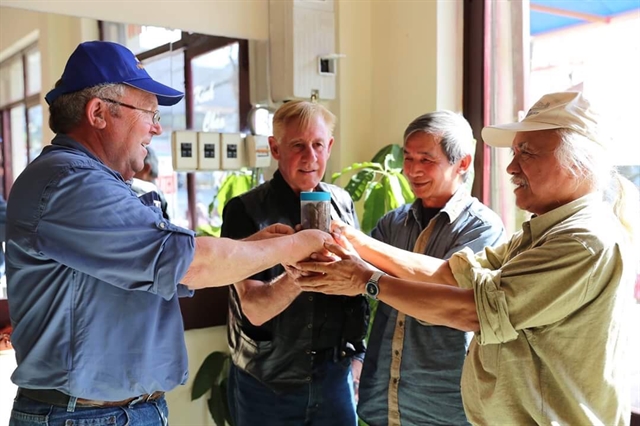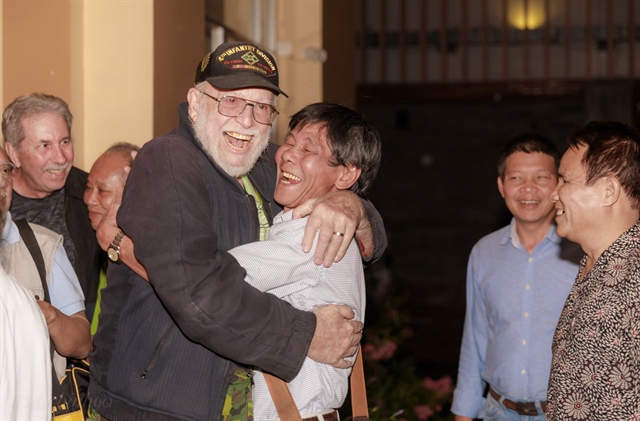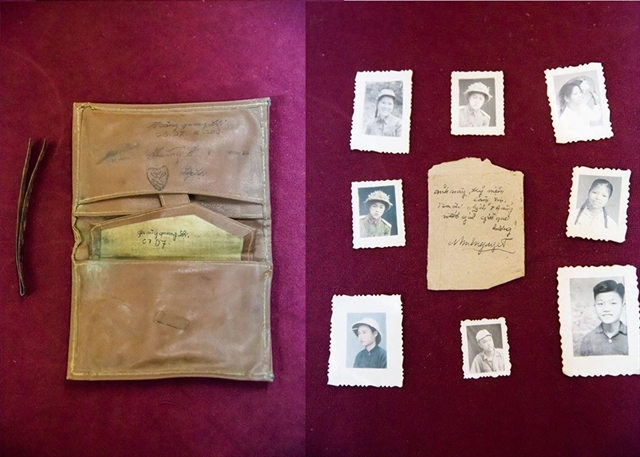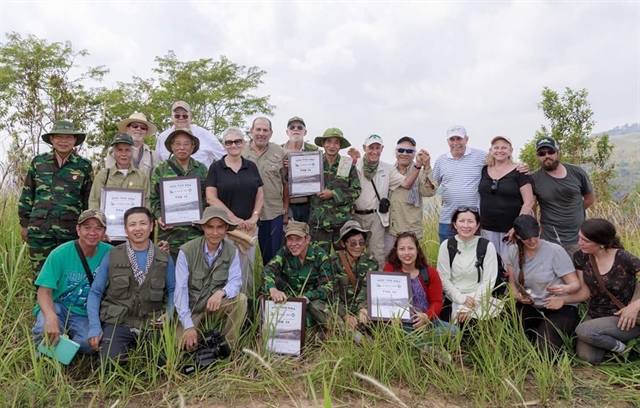 Society
Society

“When we realise that we all come together to voluntarily search for the martyrs’ remains, there is no border between us. They come here with their heart and human love. And so do we.”

|
| Vietnamese veterans Phạm Văn Chúc and Hồ Đại Đồng (first and second from right) and US veterans with a jar of soil excavated from a tunnel where US soldiers died in 1968 in Sa Thầy District, Kon Tum. Photos courtesy of Regiment 209 |
Khánh Dương
KON TUM — In March 1968, Hồ Đại Đồng and Stephens Nash Edmunds were on two sides of the battle in Chư Tan Kra Mountain.
More than 50 years later, the veterans, one Vietnamese, one American, stand on the same mountain, shaking hands and calling each other friends.
On the first days of Lunar New Year 1968, as many as 2,100 young Hanoian soldiers from Regiment 209 headed to the south to fight at the Tây Nguyên (Central Highlands) battlefield.
After a US attack on March 26, 1968, more than 200 Vietnamese soldiers laid down their lives on Chư Tan Kra Mountain, Kon Tum Province.
Hồ Đại Đồng was lucky to be among those that survived. More than 50 years after the moment he witnessed his comrades die, Đồng along with other former soldiers, both Vietnamese and Americans, keep searching for missing remains of the martyrs.
In the spring of 2009, Phạm Văn Chúc, one of the Vietnamese veterans from Regiment 209, made contact with Stephens Nash Edmunds, a US veteran who fought in 1968, to seek assistance in locating the graves of Vietnamese soldiers who died on Chư Tan Kra Mountain.
Edmunds did not hesitate and made a trip to Việt Nam six months later, bringing an aerial view of the hilltop with the approximate location of two mass graves, diaries, journals and photos, which were then precious documents for Vietnamese veterans to search for the martyrs’ remains.
“We agreed that 40 years prior we would not have hesitated to take the other one out if given the opportunity, but now we have lunch together as friends,” Edmunds recalled the reunion with Vietnamese veterans in 2009.
Edmunds then returned to Việt Nam’s southern battlefield many times with his US comrades, ate, slept and climbed the mountain with Vietnamese veterans in search for the bodies.
“Edmunds is not talkative and rarely talks about politics. We don’t know each other’s language but hug each other tightly each time we meet,” Đồng said.

|
| Stephens Nash Edmunds (left) gives a Vietnamese veteran a hug when they were reunited in 2018. |
“When we realise that we all come together to voluntarily search for the martyrs’ remains, there is no border between us. They come here with their heart and human love. And so do we.”
Over the past 11 years, the team returned to the battlefield more than 30 times, occasionally three times a year on March 26 - the death anniversary of fallen soldiers; July 27 - Việt Nam’s War Martyrs and Invalids Day and December 22 - the founding anniversary of the Vietnamese People’s Army.
"Each trip lasted between 10 and 30 days. We slept and ate in the forest," Đồng said.
“We use all possible methods to find the remains. Most of the time we use military maps and data provided by the US, but sometimes from the reports of local people and memories of veterans,” he said.
Since 2009, they have found more than 170 remains of martyrs. Nearly 90 per cent were excavated thanks to US military data on mass graves.
Many were repatriated to their homes. Others were buried at the martyr cemetery of Sa Thầy District.
In 2016, a former US soldier named John Cimino brought to Việt Nam the wallet he took from a dead Vietnamese soldier in the war.
There was Vietnamese writing inside the wallet that he did not know what it was. It turned out to be the soldier's name and unit. Thanks to the item, the Vietnamese veterans were able to contact the surviving members of the soldier’ family and make a formal presentation to them.

|
| A wallet and portraits of Vietnamese soldiers handed over to their families by US veterans. |
“When I returned to Việt Nam in 2018 on the 50th anniversary of the battle, they [Vietnamese veterans] had wreath laying ceremonies for their dead and included a wreath laying ceremony for our dead. It was very emotional," said Edmunds.
Norton Richard Paschal, who also fought in Chư Tan Kra from December 1967 to December 1968, did not have a chance to come back to Việt Nam as early as his fellows due to personal reasons.
But his first return to the battlefield in 2018, 50 years after the attack, was full of emotion.
“I was treated marvelously by former Vietnamese soldiers that I actually fought against. They treated me like a brother, as a fellow veteran. They said ‘the war is over; you were a soldier, we were soldiers. You followed your orders and we followed ours. There is no animosity left between us.”
Pass it on
Since 2017, veterans of Regiment 209 have found a way to synchronise military maps and official documents on the dead, injured and buried Vietnamese soldiers with Google Earth using Global Positioning System (GPS) to locate martyrs’ remains.
With this new technology, Đồng has pinpointed about 12,000 remains of soldiers on more than 1,000 co-ordinates on Google Earth. They fought against the US during the 1965-70 period in battlefields in central Quảng Trị, Thừa Thiên-Huế provinces and Central Highlands provinces of Kon Tum and Lai Châu.
About 70 per cent of the remains pinpointed on the map have not been excavated. About 4,000 are feasible to be found because they are located in old forests. Many were buried under houses and roads, he said.
The more we travel, the more data we collect. As a soldier, I think every martyr is our comrade. Once we know the locations, we have to go find them. We decided to expand the search to find remains of not only soldiers in our regiment but also from other battalions, Đồng said.
“I hope that the database that I built on Google Earth will facilitate the search. Maybe in the next few years, when the old veterans can no longer go on the trips, we will pass on the data to the martyrs’ next of kin so that the young ones will help us continue the work,” he said.

|
| A team of Vietnamese and US veterans on a trip in 2018 to Chư Tan Kra Mountain in search of martyrs’ remains. The trip was also joined by relatives of Vietnamese martyrs. |
Still keeping in touch with each other on social media, the Vietnamese and US veterans wish they could reunite and resume the trips back to the battlefield soon.
Edmunds said: “I was planning to return in March but had to cancel due to COVID-19. Hopefully, I will be able to come next March.”
“The men of Regiment 209 have been gracious hosts and I look forward to being with them again. Once we were enemies, now we are friends!” — VNS




